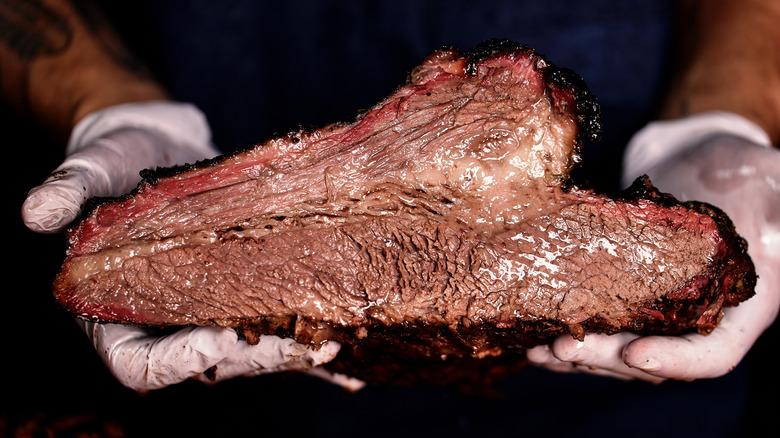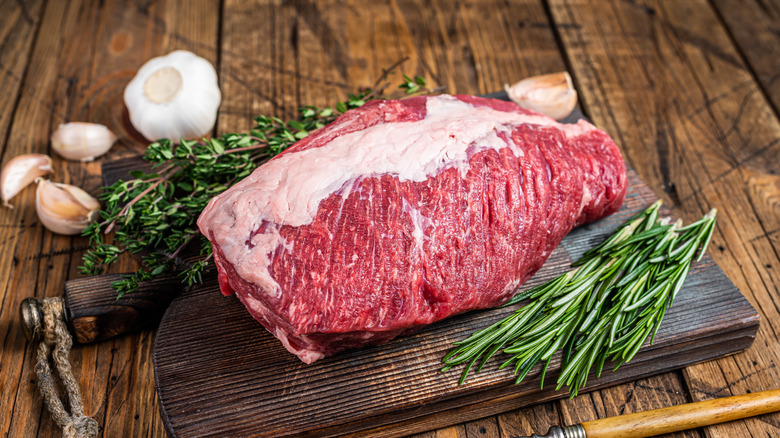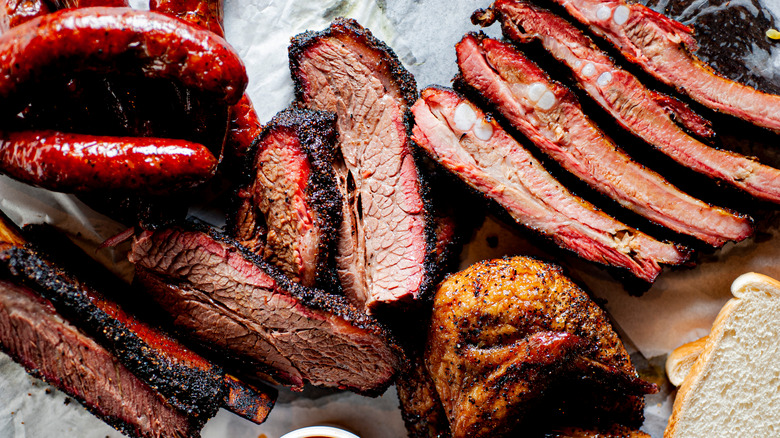The Right Amount Of Fat To Trim For A Tender And Juicy Beef Brisket
Brisket is a funny cut of beef. The cut, which comes from the chest of the cow, is a large cut of meat with a good bit of connective tissue. When cooked correctly, whether in your mom's casserole dish or a barbecue pit, it is simply divine. Yes, at its best, brisket is tender and rich, presenting an undeniable and meaty taste that will have you wanting more (even if you have to spend several hours waiting by a hot oven to get a good batch).
At its worst, however, brisket is worse than bad. A bad brisket can be tough, thanks to its high connective tissue content, and overly chewy (if there is too much fat). Now, cooking your brisket with the signature light and slow method can help with the connective tissue. But what about the fat? An important thing to know about brisket is that this cut, though generally lean, has a layer of fat on one side called a fat cap. Too much fat will make your brisket overly chewy. But then again, too little fat can leave your brisket without protection from your barbecue's high heat levels.
So how much fat should you trim from your brisket? Exact guidance tends to vary. However, in general, most brisket aficionados usually aim to trim their fat to between ¼ – ½ inches in thickness. This will give you a good amount of fat to disperse flavor without keeping that dense and chewy layer that can make eating brisket a cumbersome task.
All about that fat cap
Any piece of brisket worth its braise comes with a fat cap, the thick layer of fat on the side of the brisket cut that faces the skin of the cow. The brisket cut comes from the cow's lower chest. It is a particularly dense cut that has a good bit of collagen in its tissue, which is ideal for lower cook temperatures and slower cook times. The fat cap on a cow is usually about an inch thick, though this varies based on the cow and the butcher. But even though the fat cap provides moisture during the cooking process, it can also make your meat too chewy.
And chewiness is the enemy of a good brisket. When cooked at too high of a temperature for a short time, or with direct heat, brisket can turn tough. It's not just because of the fat, either. The connective tissue and dense muscles of brisket can make it a dense, gristly mess if not properly cooked. Add to that a thick layer of fat, and you've got yourself a ruined brisket. So you'll want to do some trimming before you put your brisket, fat cap and all, into the oven.
To cook fat up or fat down
Once your fat cap is trimmed, it's time to cook the brisket. Now comes the question: Fat cap up or down? Though some cooks swear by one method or another, the answer depends on your cooking goals. For example, if you're making braised brisket in the oven, then you should cook it with the fat side up. This will help your fat melt over your meat, trickling down and flavoring it as your brisket cooks, melding with the other seasonings in the pan. And though it isn't true that the fat melts into your meat (this simply isn't possible), this position can help to render your fat cap, which can give your meat a richer taste.
On the other hand, if you're cooking your brisket over a fire, you might opt to cook your brisket fat side down. This will shield your meat from the high temperatures of the fire and create a delicious bark on your brisket, a feature that is signature to the Texas barbecue staple. Of course, whether you cook your brisket fat up or fat down, the real key is to cook your brisket at a low heat, and over a long period. After all, this is a cut that wholly benefits from a longer cooking process (and at least a little intact fat).


